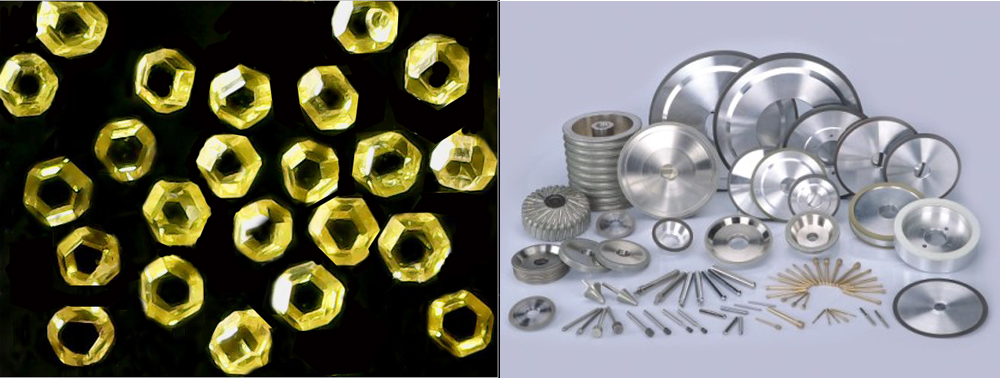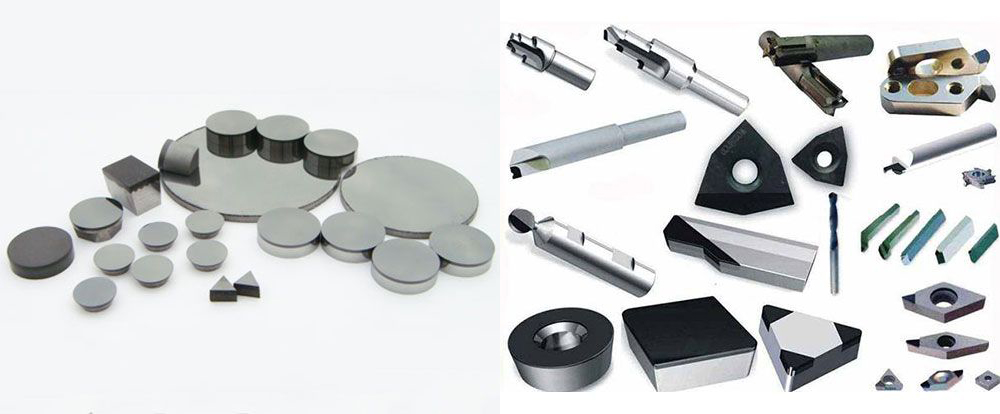
Machining Industry
Diamond abrasives are special effects tools for grinding cemented carbide. Its greatest success is the grinding of carbide tools by diamond resin wheels and bronze wheels, which promotes the progress of cemented carbide tools; it is also suitable for grinding carbide measuring tools, molds, fixtures and other carbide workpieces. Diamond has a thousand times higher grinding capacity for cemented carbide than silicon carbide. When sharpening a carbide turning tool, 4-15g of green silicon carbide abrasive is consumed per 1g of metal, while diamond consumes only 2-4g. Grinding of cemented carbide by diamond grinding wheel is thousands of times higher than that of ordinary grinding wheel, and the cost is reduced by more than 10%. The grinding wheel of the diamond grinding wheel can avoid the defects such as cracks and chipping when machining with the silicon carbide grinding wheel. The roughness and precision of the machine are high, the tool life can be extended by 50%-100%, and the tool can be omitted. The polishing process after sharpening can increase the production efficiency several times. When the diamond grinding tool grinds the alloy tool steel, the grinding ratio of the ordinary grinding wheel is increased by more than 10 times, the cost is reduced by 10%, and the burn phenomenon easily caused by the ordinary grinding wheel processing is also avoided. However, it should be pointed out that for grinding alloy tool steel, cubic boron nitride abrasive tools should be the preferred tool, which is more advantageous than diamond grinding tools. It can be used for high-speed and high-efficiency grinding and honing processing, which can greatly improve the grinding efficiency. , its grinding accuracy and quality are improved by one level.

With the development of composite PCD (polycrystalline diamond tool composite) and PCBN (polycrystalline cubic boron nitride) of diamond and cubic boron nitride, the hardened steel is processed by PCBN tool, and the hardness of the workpiece is higher than 50HRC. . The cutting speed is generally 80-120 m/min. The higher the hardness of the workpiece, the lower the cutting speed. For example, the workpiece with a hardness of 70HRC should be 60-80m/min. The cutting depth of the finished car is 0.1-0.3mm, the feed rate is 0.05-0.025mm/r, and the surface roughness of the workpiece after finishing the car is Ra0.3~0.6μm, and the dimensional accuracy can reach 0.013mm. If the standard CNC lathe can be processed with good rigidity, the rigidity of the PCBN tool is good and the edge is sharp. The surface roughness of the workpiece after finishing the car can reach Ra0.3μm, the dimensional accuracy can reach 0.01mm, and the CNC grinding machine can be used. The level of processing. If the machine tool is rigid and the cutting speed is low, the PCBN compound blade can be used to finish the surface. The finishing allowance of the finishing car is generally about 0.3mm, which can improve the dimensional accuracy and reduce the thermal deformation of the workpiece before quenching as much as possible to ensure uniform cutting allowance and prolong the service life of the PCBN tool. The finishing car generally does not use cutting fluid, because at higher cutting speeds, a large amount of cutting heat is carried away by the chips, and rarely stays on the surface of the workpiece to affect the quality and precision of the machined surface. For precision car blades, 80° diamond blades with high strength and toughness should be used. The radius of the tool tip is between 0.8 and 1.2 mm. To protect the cutting edge of the tool, a fine stone chamfer is required before use. Finished car hardened workpiece is a new process. It needs to be tested before implementation. It can be used for finishing or roughing test on the same machine tool with the same material, hardness and size. The key is to test the tool and cut. The choice of parameters and the process system are sufficiently rigid. The process has been adopted in China at present. For example, FAW Group uses PCBN tools to process carburizing and quenching (58-63HRC) 20CrMnTi gearbox shift fork groove. The process parameters are Vc=150m/min, f=0.1mm/r, ap = 0.2 ~ 0.3mm, the realization of the car to wear. When using a PCBN tool to machine hard cast iron, as long as the hardness reaches a medium hardness level (45HRC), good machining results will be obtained. For example, the exhaust valve seat on the cylinder head of an automobile engine is made of high-chromium alloy cast iron material containing copper and molybdenum. Its hardness is generally about 44HRC, and the upper hole of the valve seat adopts two processes: 锪 (hinge) and car. Most of them are processed on a dedicated automatic line, along with the gun hinge hole. The cutting amount used is: Vc=71.6m/min, Vf=26.5mm/min, ap=1.0mm, using BC broaching oil, after processing with PCBN tool, it is processed with various carbide blades used in the past. Compared with the average durability of the tool is 1,200 pieces, the surface roughness is Ra0.4 & mu; m, the valve seat surface is ≤ 0.05mm. Since the engine factory of Dongfeng Motor Corporation used PCBN tools in 1988, its effect has remained stable, which has solved the problem of localization of tools imported equipment. With the rapid development of China's automobile manufacturing industry, the domestic tool industry is also extremely active and flourishing.

Our FSD synthetic diamond fines, diamond crushed material, diamond micropowder, cubic boron nitride CBN, cubic boron nitride micropowder, polycrystalline diamond PCD, polycrystalline cubic boron nitride PCBN are widely used in metal processing, machining and automotive industries. And other fields.
Prev:Drawing Dies Tools
Next:The Construction Industry
PRODUCTS:
Copyright © 2018 Henan Baililai Superhard Materials Co., Ltd. All rights reserved. Powered by MetInfo
TOP

 简体中文
简体中文 English
English Pусский
Pусский
.jpg)